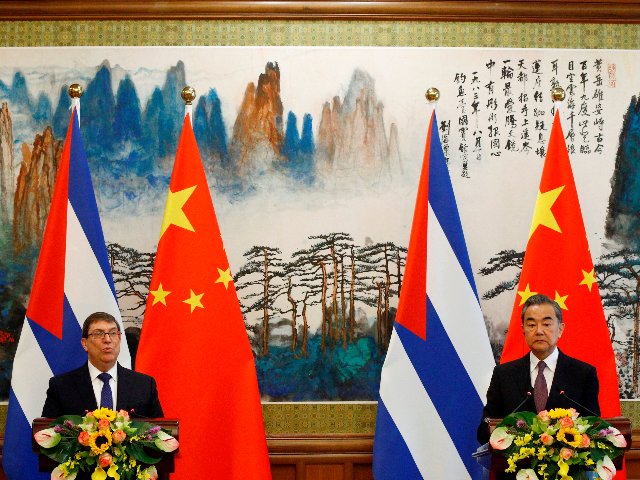China’s Xinhua news agency published images Sunday of the debut of a new, Chinese-built railway connecting Havana to Santiago de Cuba, the largest cities on the east and west coasts of the island, respectively.
The project follows recent declarations by Cuba’s second-in-command, Miguel Díaz-Canel, that the communist government in Cuba was interested in joining China’s Belt and Road Initiative (BRI), a global infrastructure program.
BRI, previously known as One Belt, One Road (OBOR), is Chinese Communist Party leader Xi Jinping’s plan to ensure that China dominates the world’s major transportation infrastructure, building or rebuilding some of the largest ports, roads, and railways on earth. The Chinese communist regime initially described the goal of the plan as reconstructing the Ancient Silk Road, which connected eastern China to western Europe but has since added projects in Africa, the Indian Ocean coasts, and Latin America.
Chinese officials have attempted to claim that Latin America was part of the Ancient Silk Road through the Spanish conquest of Mexico.
Cuba bought 80 rail cars from China in May, the first new rail cars put to use on the island in 44 years, according to Xinhua. Cuba has largely resisted new transportation technology, a product of the retrograde ideology of communism that governs Havana. As China is also a communist country, the Cuban regime agreed to purchase the new rail cars. The Chinese state media outlet reported that, in addition to the first 80 cars, Cuba will receive “80 each year from 2019 to 2021 … acquired with a Chinese loan payable in 15 years.”
The government of the United States has repeatedly warned developing countries that the loans China grants to pay for BRI projects often come with high interest rates and are designed to bankrupt the debtors. In countries like Kenya, Sri Lanka, and the Maldives, governments have struggled to pay the loans back, resulting in the nations having to take out even more loans to pay the initial loans and, in some cases, handing over control of the BRI projects to China. China then receives payment for the loans and keeps control of the projects the developing country paid for. In many instances, China will also demand the projects be built by Chinese workers, meaning the loan money initially returns to China through the workers, then once again through loan payment or Chinese takeover of property.
Cuba’s economy is has been on a significant economic downturn in the past year, resulting in severe food shortages and rations that have left Cubans forced to stand on line for hours to buy rancid meat. Despite widespread protests against the government for failing to import or produce sufficient food for the population of the island, Cuban officials have claimed that tightened food rations are popular.
The first new train from Havana to Santiago departed the capital on Sunday. Havana and Santiago de Cuba are about 540 miles apart, a four-hour flight. The train will take 14 hours to conclude its journey but will provide luxury amenities compared to what Cubans are used to for their travels.
In addition to Santiago, the train will connect the western Cuban capital to the towns of Guantánamo and Holguín, deep in the nation’s east.
Xinhua did not identify the train as a Belt and Road project, but it fits the description of other global BRI projects – most prominently the Standard Gauge Railway that promises to connect Uganda, Kenya, and Rwanda – and it follows affirmative statements from Díaz-Canel that his country wanted to join the BRI.
During his visit to Beijing in November – part of a tour of allies in Asia that also included stops in Moscow and Pyongyang –Díaz-Canel signed cooperative agreements with the BRI. Chinese Premier Li Keqiang agreed, as part of the deal, that China would invest in “new energy, information communication, and biological pharmacy” in Cuba as part of a mission to improve bilateral ties.
The formal BRI move followed Cuba’s decision to sign a cooperation agreement in June 2018 between its Chamber of Commerce and China’s “Council for the Promotion of International Trade,” according to the state-run outlet China Daily,
“Chinese products are present in a wide range of areas of Cuban life such as health, education, technology and sports, transport, among others,” Orlando Hernández, the head of the Cuban Chamber of Commerce, said at the time. “Cuba hopes to get involved in the BRI with true commitment and believes that it will contribute to attracting further Chinese investment in our country as we update our economic model.”
In April, Cuban Vice President Gladys María Bejerano visited Beijing to again discuss the implementation of Belt and Road in Cuba. Bejerano went to Beijing as an official Havana representative to the Belt and Road Forum for International Cooperation.
In February, Admiral Craig Faller, the head of U.S. Southern Command (SOUTHCOM), warned that China has “accelerated expansion of its Belt and Road Initiative [in Latin America] at a pace that may one day overshadow its expansion in Southeast Asia and Africa.”
“China utilizes the same predatory, non-transparent foreign lending practices [in Latin America] it has implemented around the world to exert political and economic leverage in certain countries,” Faller said in SOUTHCOM’s 2019 posture statement. “China has pledged at least $150 billion in loans to countries in the hemisphere, and 16 nations now participate in the Belt and Road Initiative.”

COMMENTS
Please let us know if you're having issues with commenting.